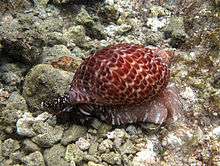Tonna perdix
Tonna perdix, common name the partridge tun, is a species of very large sea snail, a marine gastropod mollusc in the family Tonnidae, the tun shells.[1]
| Partridge tun | |
|---|---|
| Dorsal view of a shell of Tonna perdix | |
 | |
| An image of a live individual showing the siphon | |
| Scientific classification | |
| Kingdom: | |
| Phylum: | |
| Class: | |
| (unranked): | |
| Superfamily: | |
| Family: | |
| Genus: | Tonna |
| Species: | T. perdix |
| Binomial name | |
| Tonna perdix | |
| Synonyms[1] | |
|
synonymy
| |
Description
The pattern and brownish colour of the shell is reminiscent of a partridge's plumage hence the common name. The size of an adult shell varies between 70 mm and 220 mm.
The ovate-oblong shell is ventricose and pretty thin. It is of a reddish-brown color, pleasingly varied with white spots in transverse series, for the most part semi-lunar, and more or less distant. The conical spire is slightly projecting and, pointed. It is composed of from five to six whorls which are furnished with numerous ribs, often widened, feebly convex, and separated by furrows hardly apparent. The suture is very distinct and is slightly channeled towards the body whorl. The aperture is large, subovate, marked by transverse and slightly projecting bands, which correspond to the furrows of the exterior. The interior of this cavity is of a fawn color. The outer lip is thin, everted, a little undulated, and adorned with a white band the whole length of its interior, with the exception of the edge, which is of a deep brown. The inner lip is spread out over the body of the shell. It is very thin, transparent, and terminated below by a projecting plate which covers the umbilicus, and seems also to form a part of it. The columella is smooth, polished, and forms at the left of the umbilicus a thick rib, marked by transverse striae, which terminates at the emargination of the base. [2]
The ground color of the shell is a bluish white, covered with irregular spots of a red brown, bordering upon the violet. The foot is colored in the same manner beneath, but above, it is furrowed with wide triangular radiating bands. The tentacles are doubly ringed with brown. [2]
Distribution
This species occurs in the Red Sea and in the Indian Ocean off Aldabra, Chagos, Madagascar, the Mascarene Basin, Mauritius and Tanzania, and in the Pacific Ocean off New Zealand, Australia (Northern Territory, Queensland, Western Australia) and the Galapagos Islands.
The mollusk of this shell inhabits rapid waters, and appears pretty quick in its movements.[2]
Biology and diet
This gastropod is a highly specialized carnivorous predator, preying on sea cucumbers.[3]
References
- Vos, C. (2010). Tonna perdix (Linnaeus, 1758). Accessed through: World Register of Marine Species on 2011-04-26.
- Kiener (1840). General species and iconography of recent shells : comprising the Massena Museum, the collection of Lamarck, the collection of the Museum of Natural History, and the recent discoveries of travellers; Boston :W.D. Ticknor,1837 (described as 'Dolium perdix)
- Philippe Bourjon & Sébastien Vasquez (2016). "Predation by the gastropod Tonna perdix (Gastropoda: Tonnoidea) on the holothurian Actinopyga echinites (Echinodermata: Holothuroidea) on a reef of Réunion" (PDF). SPC Beche-de-mer Information Bulletin. 36.CS1 maint: uses authors parameter (link)
- Linnaeus, C. 1758. Systemae naturae per regna tria naturae, secundum classes, ordines, genera, species, cum characteribus, differetiis, synonymis, locis.v. Holmiae : Laurentii Salvii 824 pp.
- Schröter, J.S. 1788. Vollständiges Alphabetisches Namen Register von........ Conchylien Cabinets. Nürnberg : Raspe 124 pp.
- Röding, P.F. 1798. Museum Boltenianum sive Catalogus cimeliorum e tribus regnis naturae quae olim collegerat Joa. Hamburg : Trappii 199 pp.
Bibliography
- Philippe Bourjon & Sébastien Vasquez *date=2016. "Predation by the gastropod Tonna perdix (Gastropoda: Tonnoidea) on the holothurian Actinopyga echinites (Echinodermata: Holothuroidea) on a reef of Réunion" (PDF). SPC Beche-de-mer Information Bulletin. *volume=36.CS1 maint: uses authors parameter (link)
- Hedley, C. 1919. A review of the Australian Tun Shells. Records of the Australian Museum 12(11): 329-336, pls 39-44
- Dautzenberg, Ph. (1929). Mollusques testacés marins de Madagascar. Faune des Colonies Francaises, Tome III
- Turner, R.D. 1948. The family Tonnidae in the western Atlantic. Johnsonia: Monographs of the marine mollusks of the Western Atlantic 2(26): 165-192, pl. 74-85
- Kilias, R. 1962. Gastropoda/Prosobranchia. Tonnidae. Das Tierreich 77: 1-63
- Kay, E.A. 1979. Hawaiian Marine Shells. Reef and shore fauna of Hawaii. Section 4 : Mollusca. Honolulu, Hawaii : Bishop Museum Press Bernice P. Bishop Museum Special Publication Vol. 64(4) 653 pp.
- Drivas, J. & M. Jay (1988). Coquillages de La Réunion et de l'île Maurice
- Wilson, B. 1993. Australian Marine Shells. Prosobranch Gastropods. Kallaroo, Western Australia : Odyssey Publishing Vol. 1 408 pp.
- Vos, C. (2007). A conchological Iconography (No. 13) - The family Tonnidae. 123 pp., 30 numb. plus 41 (1 col.) un-numb. text-figs, 33 maps., 63 col. pls, Conchbooks, Germany
- Spencer, H.; Marshall. B. (2009). All Mollusca except Opisthobranchia. In: Gordon, D. (Ed.) (2009). New Zealand Inventory of Biodiversity. Volume One: Kingdom Animalia. 584 pp
- Beu, A.G., Bouchet, P. & Tröndlé, J. 2012. Tonnoidean gastropods of French Polynesia. Molluscan Research 32(2): 61-120
Further reading
- Powell A. W. B., William Collins Publishers Ltd, Auckland 1979 ISBN 0-00-216906-1
| Wikimedia Commons has media related to Tonna perdix. |